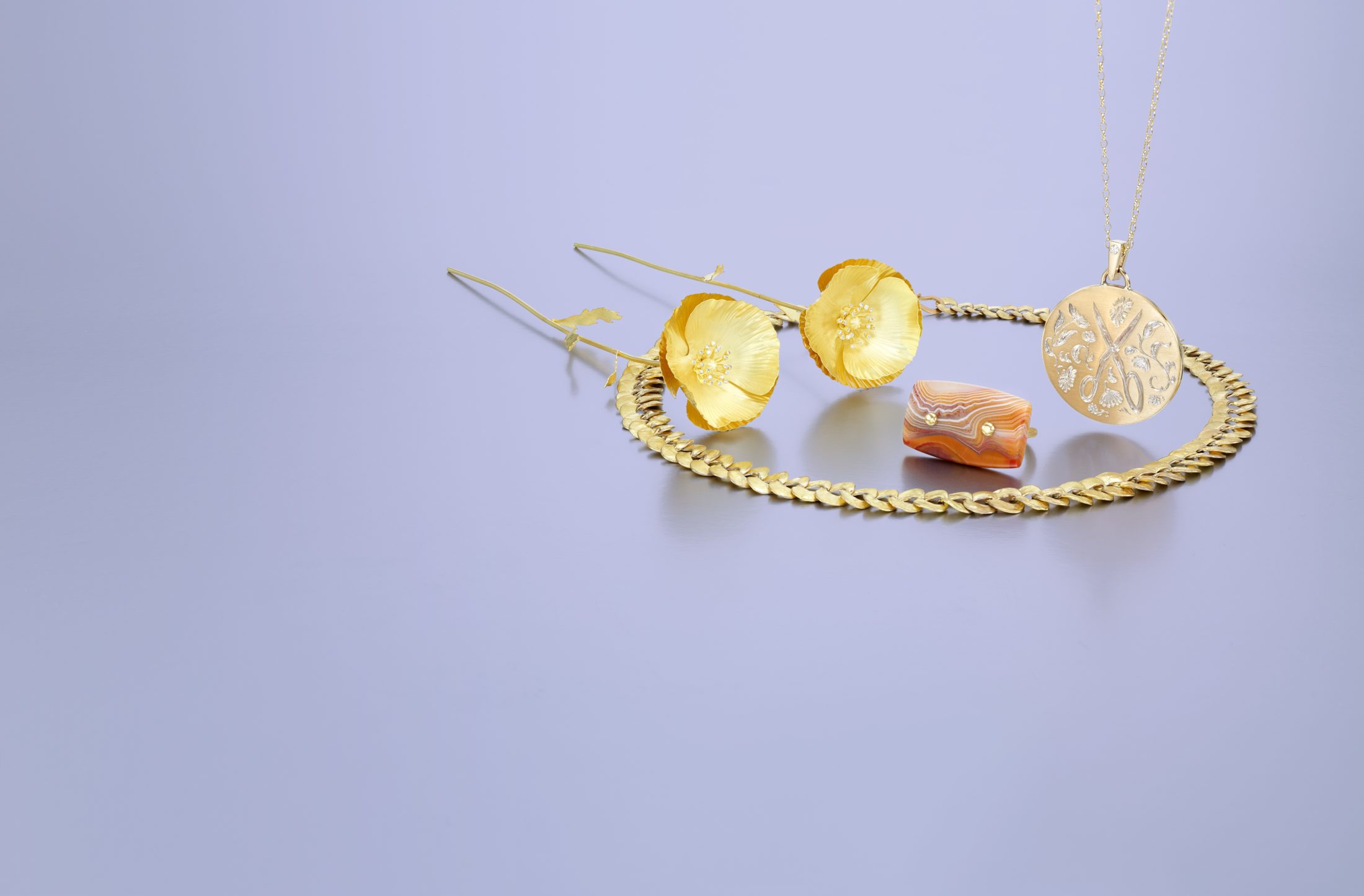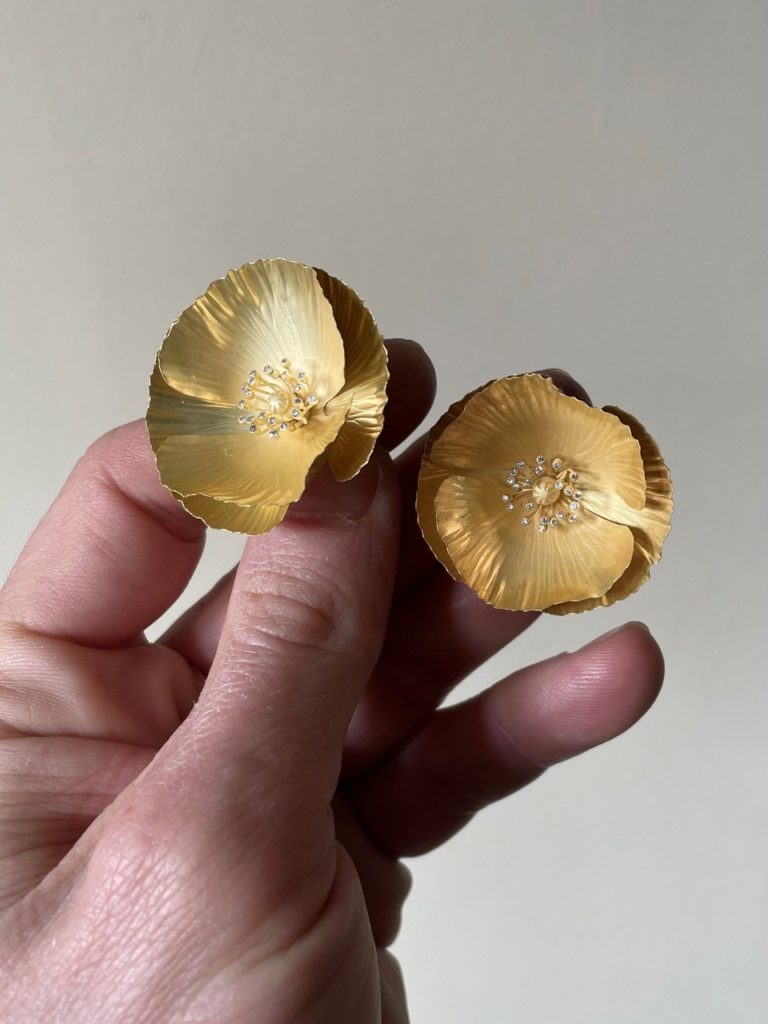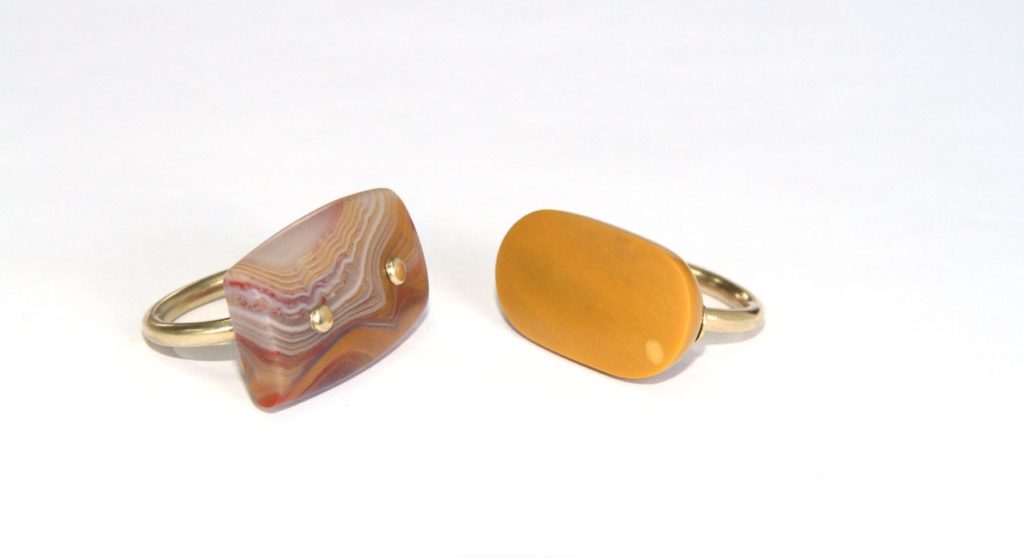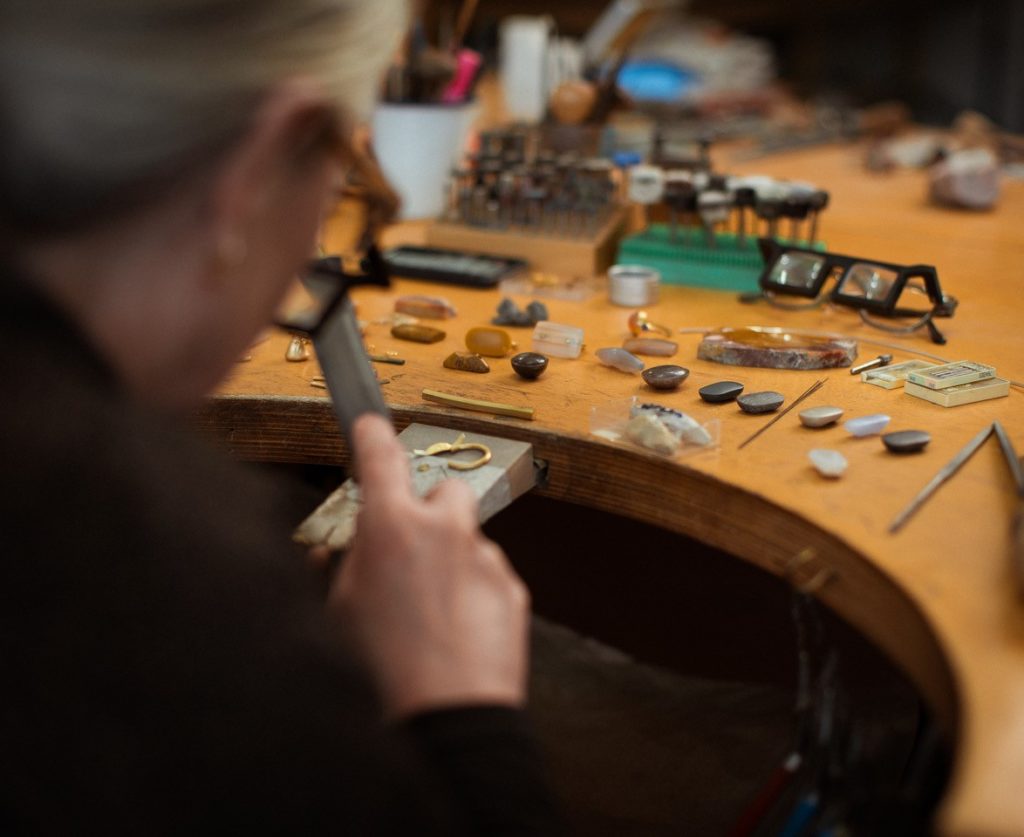QUARTET: Goldsmiths in London Now

By Naomi Filmer
During London Craft Week 2022 Sotheby’s presents a selling exhibition comprising four makers of contemporary fine jewellery: Lucie Gledhill, Christopher Thompson-Royds, Castro Smith and Sian Evans.
It takes real cunning, wisdom and sound confidence in technique for a craftsperson to perceive, then work out how to realise, the implicit potential for the transformation of natural materials into beautiful cultural objects.
Understanding the significance of these four fine jewellery makers, both as a group and as individuals, it is worth noting their similarities and differences. Each represent contemporary craft, positioned in the fine jewellery context. In this piece we focus how their craft, as professional creative practice, is a means to produce objects of beauty that carry significant cultural relevance.
Collectively they are all fine makers, working in gold and employing millennia–old techniques that date back to the Bronze Age. They each make archetypes of jewellery that break conventions. They generate work with a sense of the natural and its emergence in its own time, whether through the geological sedimentation of rock and stone, the botanical evanescence of wildflowers, or the alchemy of metallurgical transformation. They demonstrate imaginative transformations and share ecological concerns. Yet it is the character of engagement in the making and their underlying creative impulses that differentiate these four jewellers and informs their work through aesthetics, purpose, design and research.
Lucie Gledhill the Alchemist
Lucie makes chain. She is a master in the hand making of chains to extreme and varied forms, differing in scale, length, weight and proportion. But it is Lucie’s exploration into the chemical nature of precious metals that shows her to be an inquisitive alchemist. The crafting of chain manifests linear formation as it follows many iterations of link to link from molecular sequences and travels the drawing of wire along the draw bench, to the formation and joining of links. She describes silver as surprising in its shifting guises, magical properties and varying states from solid to molten. This desire to understand on a scientific level how material transformation allows for its manipulation has subsequently informed Lucie’s work as both maker and researcher.

Her design approach refers to archetypal chain patterns translated into contemporary adaptations – rope chains formed from an abundance of wire links that individually appear as fine, thin, unusually long and flimsy, but en masse, when assembled and twisted in unison, they form an impressive volume as statement necklace; curb chain constructed from links that are each graduated in scale and collectively present a dramatic impression of swelling along the line of the chain. Lucie’s studio methods are traditional in both procedure and technique: ingots of fine silver or gold are drawn into wire, then forged, formed and twisted into links. The making of and connecting together each link of her chains is repeated with meditative rhythm driven by process and skill, and dictates a discipline of (slow) time, yet offers reassurance in the knowledge that repetitive action provides cumulative results, as Lucie’s focused practice yields masterfully.
Christopher Thompson Royds the Naturalist
Christopher makes flowers. More precisely he makes jewellery in the form of wildflowers; necklaces as intertwined daisy chains and drop-earrings of swaying poppies. Gold wire and gold sheet of paper-thin proportions are rolled, formed, wrapped and forged to create delicate translations of common field flowers – some appear as if pressed, others as if freshly picked. In his delicate crafting Christopher reveals considered studies of botanic formation, as convincing as it is poetic, and strikes an aesthetic balance between naturalness and designed simplicity.

Interpretations of flora in jewellery follow an ancient tradition of human desire to adorn and decorate, but also to capture the ephemeral qualities of nature. It is with this impulse to capture the natural as evanescent and to document the study of its organic behaviour that Christopher shows himself as a naturalist.
There is a lightness that runs through Christopher’s work: in appearance it is delicate, in the physical it is weightless and on the body it is intuitive – as if wearing the flowers just picked on a walk, barely there and already breaking. The lightness reflects the sense of impermanence as central in this work, but also exists as transience in his life. Christopher has never set up his own studio as a long-term base but is happy to work in temporary solutions – his Mum’s shed, at a friend’s spare jewellery bench, a place on a residency or at his kitchen table. This transience resonates suitably with the history of European medieval goldsmithing journeymen, who travelled from Master to Master to attain new skills and increase their knowledge.
Yet there is poignant permanence in Christopher’s work too. He is masterful in his nimble manipulation of fine gold sheet, transformed into fragile flora with the purpose of capturing a fleeting existence, but confident in the knowledge that gold will long outlive the botanical formation he depicts…a symbolic reference to the volatile ecology of our planet today.

Christopher is clear that he wants his work equally present when worn and not worn, a consideration of display that returns to the notion of the Victorian naturalist packing his collections as if specimens for scientific research in handmade paper folios, or housed under a glass bell jar, worthy of a place in a cabinet of curiosities.
Castro Smith the Illustrator and Storyteller
Castro engraves. His training, initially as painter and printmaker at art school, then as jewellery engraver at Hatton Garden, followed by a year of silversmithing under the Japanese master, Hiroshi Suzuki have provided him with the resources for this.
The illustrative quality of his work is explosive. Elaborate figurative detail sprawls beyond the traditional frame of the seal on the upper surface of a signet ring, colonising its entire surface. Flora and fauna are depicted in an animated narrative that reaches beyond the boundaries of both jewellery and the hand that wears it. Castro describes himself as more an illustrator than an engraver, but the two modes of practice are not mutually exclusive, and he employs both in transforming the traditional character of the signet ring as jewellery into a sculpted icon customised to the wearer’s identity.
His creative impulse is in storytelling with imaginative illustration, drawing in part on his long-term passion for gaming, but more so on ancient histories, myths and legends that recount human behaviours and personas. The signet ring serves as the perfect artefact to facilitate these tales and draws a connection to engraving as ancient technique employed to carve seals and stamps to officiate documents and authenticate identity. Today Castro seeks to encode the particularities of his customers, as a contemporary take on cultural identity.



Describing his technique, Castro tells of cutting inversions into the metal, like a ridge to subvert the lines of drawing. He cuts in layers and in sequence. He sands to matt the micro surface of each ridge, then cuts back in again and again. Light and reflection describe form and to craft the technique requires a trained eye to read the shadowy angles that confirm the line. Canny how these shadows he follows are evocative of the histories and mysteries he inscribes onto the ring.
Sian Evans the Archaeologist and Geologist
Sian cuts stone. Her jewels are carved from native hardstones, collected from British beaches, rivers banks and mountainside – agates, jasper, chalcedony and flint. She cuts back, grinds in, carves out a multitude of Bronze Age-inspired forms, bold and familiar in shape. Each form is then married to finely wrought recycled gold attachments and resolved as jewel.

These honed stones are striped of adornment. Their surfaces, once polished, reveal breath taking displays of fine banding – waves of undulating line and concentric patterns, accented with spots and bubbles, layered with a spectrum of colour, gradient shades and translucency. They are extraordinary and unique. Unrepeatable and undeniably glorious in their presentation of the natural and organic, they pose a radical shift in scale from material mass to fine jewellery details.
Sian is fascinated by geology, serving as a window into pre-history and a tangible account of unimaginable time. Equally she is fascinated by Archaeology for uncovering traces of human civilisation, behaviours and innovations. Both areas of interest she attributes to living in Dorset for much of her childhood – an area abundant with traces of ancient human activity and a coastline famously plentiful with fossils. It is the desire to uncover and discover that informs Sian’s long-term professional practise as a jeweller. Her inquisitiveness in ancient cultural history, Bronze age in particular, propelled her from art school technical training through 30 years of professional practice, continuing to attain an ever-growing spectrum of techniques. She casts, forms, constructs, carves, sets and finishes her work in house.

Photographer: Rosie Taylor
Sian’s design methodology is to build collections directed and disciplined by technologies the materials demand. Effectively each collection becomes an ode to the ancient craft techniques they derive from and encompass her ethical, political and material concerns in opposition to mass production.

Photographer: Rosie Taylor
